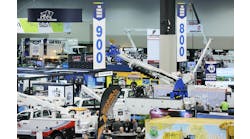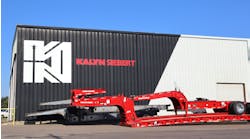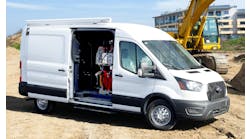With an effort to win more vocational market share located in rougher U.S. topographical areas, the 2015 model Sprinter van is introducing a new 4x4 optional suspension package.
“It’s a great opportunity for us to win the business of the plumber in Bangor, Maine, the hotel resort in the Rocky Mountains, natural gas field workers in the Midwest, and oilfield operators in Texas,” Claus Tritt, GM for commercial vans for Daimler AG’s Mercedes-Benz USA (MBUSA) division, explained to Fleet Owner here during a special ride and drive event at the Sprinter’s U.S. assembly plant in Ladson, South Carolina.
“It’s an even greater opportunity since at the end of the day it is really a 4x2 suspension that provides 4x4 capability when needed; it’s an on-demand system,” he stressed. “So now we have a true van competitor to the 4x4 Quad Cab pickups in tough places like the oil fields, offering more enclosed load- and tool-carrying capability.”
While the 2015 Sprinter 4x4 van is not officially considered an “off-roader” by the OEM, its factory-installed all-wheel drive system distributes torque at a ratio of 35:65 between the front and rear axle via an electronic traction system dubbed “4ETS” that’s push-button activated by the driver.
The OEM added that the 2015 Sprinter 4x4 can also be equipped with an optional low range gear that makes it even more sure-footed in difficult terrain, so when the driver pushes the low-range button, gearing is shortened by 42% with traction power increasing accordingly.
MBUSA also boosted the 2015 Sprinter 4x4 body height by 4.3 inches at the front and 3.1 inches in the rear to help increase its slope-climbing ability by 20% higher compared to a Sprinter equipped with a conventional 4x2 drive system.
Depending on the body style, the all-wheel drive system of the Sprinter 4x4 adds about 265 lbs. in weight, the OEM said, noting that a “high range” only 4x4 package will cost $6,500, with a high-and-low 4x4 system costing $6,800.
Tritt told Fleet Owner that’s comparable to the $15,000-$20,000 cost for an aftermarket-installed 4x4 van suspension package. “We think we’ve priced this decently,” he said.
Tritt also noted that U.S. sales of Sprinter vans are on something of a tear of late, with sales expected to be up 19% for 2014 overall versus 2013.
He added that Sprinter sold 21,816 units in the U.S. last year – second only to sales in Germany – with 18,000 units sold this year through September. That’s compared to 8,500 units sold back in 2010, Tritt pointed out.
Mathias Geisen, GM-product management/marketing for MBUSA’s commercial van group, added that the standard engine for the 2015 Sprinter will remain its new 2.1-liter four-cylinder diesel, which produces 161 hp and 266 lb.-ft. of torque at 1,400-2,400 rpm mated to a 7-speed automatic.
However, to spec the new 4x4 suspension package, buyers will need to spec Sprinter’s optional 3.0-liter V6 diesel motor that cranks out 188hp and 325 lb.-ft., married to a 5 speed transmission.
Other upgrades for the 2015 Sprinter model Geisen noted include:
- An optional super-low emission vehicle (SULEV) variant of its 2.1-liter 4-cylinder diesel;
- A new “super high-roof” option that offers 7 feet of interior height;
- Service intervals boosted to 20,000 miles;
- Crosswind Assist, which will be a standard safety feature on all 2015 Sprinter 2500 models.
Base U.S. pricing for 2015 model Sprinter cargo vans equipped with its 4 cylinder diesel and 7-speed automatic will range from $35,995 for the 2500 platform to $44,485 for the 3500 variants.
Cab chassis pricing will range from $35,310 to $35,800, while crew cab vans will run from $38,270 to $45,550 – differences based on wheelbase lengths, gross vehicle weight ratings (which can range from 8,500 to 11,030 lbs.) and other features.
Tritt emphasized that the combination of great safety and ergonomics with economical cost ownership plus the service backing of a 257 dealership network spanning the U.S. (200 Mercedes Benz and 57 Freightliner locations) is what he believes will ultimately buoy sales of the OEM’s new 4x4 package in the construction trade market – a segment that represents 60% of all U.S. Sprinter sales.
“If you measure the van only by the upfront cost, you’re making a big mistake,” he said.








